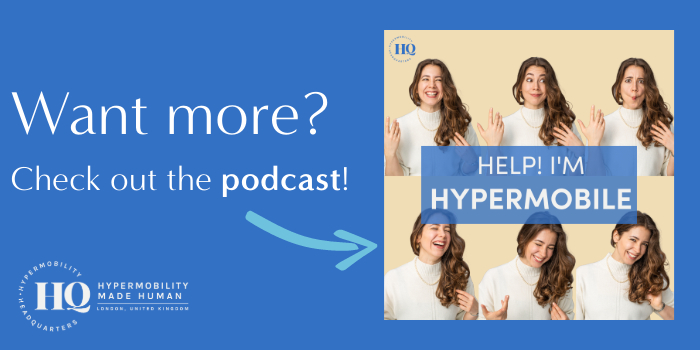My Checklist of Things I Wish Every Hypermobile Person Knew About Pregnancy

Hypermobile connective tissue has wide-ranging and profound effects on everything for affected individuals, including their experience of pregnancy. In this episode of the Help! I’m Hypermobile podcast I shared my perspective as a Hypermobility Specialist Osteopath on a few things that I wish hypermobile people were more aware of when it comes to pregnancy.
[Please be aware that as an Amazon Associate I earn from qualifying purchases. By purchasing through links in this post you help to support me in providing useful information to hypermobile people through this website. Thank you for your support]
Estimated Reading time: 12 mins
HYPERMOBILITY, hEDS, HSD AND PREGNANCY
Pregnancy is a complex, wide-ranging, and quite frankly mind bogglingly experience (I say this as someone who has never been pregnant). Although there are profound changes of all kinds for every pregnant person, early on in my career when taking medical histories from my hypermobile patients it became evident that they experience some issues more frequently than their collagen-typical peers. However, what also became evident is how variable the experience of the hypermobile pregnant person is, with pregnancy experiences ranging from uneventful (or even occasionally great!) to overwhelmingly negative or even heart-breaking.
Suffice to say, it’s complicated.
What I can say though is that making this podcast episode gave me a LOT of time to reflect and think on what I would do if I were to get pregnant. So today, I’m sharing Alex’s Checklist of Things For Pregnant People To Speak With Their Healthcare Providers About.
I hope you find it helpful.
P.S. as always this is not medical advice in any way/shape/form. If you are looking to use this advice to make any changes to your health please be sure to speak with your qualified medical doctor in advance.
Alex’s Checklist of Things for Hypermobile Pregnant People To Speak With Their Healthcare Providers About

Pre-Pregnancy:
METHYLATED FOLATE
- We all know that folic acid is REALLY important for growing a human (basically it helps make sure that cellular division happens correctly, and it is particularly important for nervous system development). But did you know that some people do not absorb folic acid as well as others (and that recent research suggests that hypermobile people in particular might have issues with folic acid absorption)? In fact, in 2023 a group of researchers proposed a new type of hypermobility syndrome caused by methylenetetrahydrofolate reductase (MTHFR) mutations (you can read more about it here: PMID: 37095957). Long story short: if you’re hypermobile you REALLY want to make sure that you’re getting enough of this important micronutrient in your diet, especially if you’re pregnant or thinking of getting pregnant!
- The good news even if you might be someone that either knows you can’t or suspects you might not be able to absorb folic acid is that there are versions of folate that exist where the methyl group has already been added. By taking a methylated folate supplement you are taking folic acid where the “work” of adding the methyl group (which makes the folic acid bioavailable) has already been done for you. Think of it like buying frozen chopped onions as a shortcut when cooking instead of having to chop onions yourself.
- One last thing: as with any supplement please be careful (and speak with your medical doctor) to make sure that you’re taking the correct dose. My favourite online resource for checking supplement information is Examine.com (although they have a TONNE of great info for FREE, if you do end up purchasing a paid membership through this link I receive a small commission at no cost to you, which helps to support the running of this site). I have been using Examine regularly for the last decade, and it is one of my “Desert Island” resources when it comes to supporting both my own health and my clinical work with patients.
SUMMARY: taking a methylated folate supplement (you should see L5MTHF or L-5-methyltetrahydrofolate somewhere on the label) can be an easy way to bypass potential issues with folic acid absorption. L5MTHF supplements can be purchased without a prescription in the UK, but please be sure to speak with your medical doctor and make sure that you are purchasing a high-quality supplement (you can check out my Amazon Shop HERE if you’d like to see some of my favourites!).
PREHAB
- Prehab (rehabilitative exercises done BEFORE an event that is expected to be physically stressful) is big in the world of sports physio, and it needs to become something we think about more often when it comes to hypermobility and pregnancy! Pregnancy is a physically stressful experience for anybody, period (just like a sporting competition). And in the case where a pregnancy is planned, doing rehabilitative exercises to prepare for the physical challenges of pregnancy and going into your pregnancy in the best health possible is a wise decision.
From my perspective as a Hypermobility Specialist Osteopath, I would recommend that a pre-pregnancy prehab exercise programme focused on:

- Cardiovascular Fitness (specifically Aerobic Fitness). I would use my Steady State Training Guide (you can find it HERE) and focus on safely, slowly, and gradually increasing my heart’s ability to deal with the physical stress of exercise. And if I was someone who had any cardiovascular concerns or diagnosed conditions (such as Postural Orthostatic Tachycardia Syndrome) then of course I would be speaking with my medical doctor about this before starting ANY kind of exercise programme!
- Strength Training. I would want to try to find ways to safely build muscle mass or to at least maintain whatever I had going into my pregnancy. Since it takes a person with collagen-typical connective tissue on average 12 weeks to gain a noticeable amount of muscle mass, ideally strength training would begin more than 12 weeks in advance of pregnancy. I would want to focus on core strength in particular with a focus on my lower abdominals and hip musculature (but building muscle anywhere is generally a good thing for hypermobile people!).
- Pelvic Floor Health. I almost typed this as pelvic floor strength, but the reality is that many hypermobile patients have pelvic floors that are TOO tight (in contrast to their otherwise often widespread hypermobile connective tissue). So I would want to try to find a qualified pelvic floor physiotherapist who I trusted and work carefully on balancing the muscular tone of my pelvic floor. If I couldn’t afford or couldn’t find a pelvic floor physio to work with then I would try to carefully research this and find support online. I personally would avoid kegel exercises, as I find that (like many hypermobile people) they have never been particularly beneficial to me.
BASELINE MEDICAL TESTS
In healthcare, a baseline test refers to a test which is done to determine what YOUR “normal” is. Although baseline tests are not done regularly in most healthcare systems it is important to note that this is generally due to cost. Baseline tests are an invaluable part of preventative medicine, and something that I think more patients should be aware of.
If I had a scoliosis, I would consider trying to get a lumbar spine MRI pre-pregnancy. This is because the weight of the growing fetus during pregnancy can place stress on the low back and can, in some instances, exacerbate/change a scoliosis. Just in case I had any serious low-back pain issues post-pregnancy I would want a baseline lumbar spine MRI pre-pregnancy to help my medical team post-pregnancy figure out whether any physical changes to the spine during pregnancy might be the cause of my symptoms, as this would potentially affect treatment.
Another baseline test which some patients would certainly want to consider is an echocardiogram (ultrasound of your heart). The reason for this is that due to a significant increase in blood volume during pregnancy as well as pronounced hormonal changes sometimes a patient who previously did not have any heart issues pre-pregnancy can develop them during or post-pregnancy. Although theoretically in a perfect world every hypermobile patient would have this test done, it is particularly important for patients who have known heart issues or a family history of heart issues.
LITERALLY JUST THINKING ABOUT WHETHER PREGNANCY (AND PARENTHOOD!) WAS RIGHT FOR ME
A person’s experience of pregnancy and parenthood is affected by much more than just their experience to physically carry a pregnancy.
I would ask myself. . .
- Do I have enough financial resources to be able to make this work? Do I have enough money so that if my health declines post-pregnancy and I’m no longer able to work that things will be okay?
- Do I have enough family/found-family/friends to support me through this? Even if your partner is supportive and theoretically would be a hands-on co-parent, with rising childcare costs (and costs of everything quite frankly) family/found-family support can make a huge difference in managing the demands of parenthood
- Am I prepared to support my child if they’re hypermobile? As I discussed in a previous blog post (you can find it HERE) Hypermobile Ehlers-Danlos Syndrome (hEDS) is an autosomal dominant condition. This means that if one parent is affected, then there is a 50% chance that a given child will also have hEDS. And since the presentation of hEDS varies from individual to individual (even within families), there is a risk that a child could be more affected than the parent.
This stuff is hard, and there are no clear answers. Every situation is different, but I believe that thinking about these things and having candid conversations with your partner and other loved ones in your life can help you to make the decision that is right for you.
Pregnancy
COMPRESSION GARMENTS: THINKING OUTSIDE THE BOX
I already often wear high-waisted compressive yoga pants because they help with blood pooling. If I was pregnant, I expect I might live in them. This is because due to an increase in blood volume hypermobile people are at a greater risk of vascular issues such as varicose veins. The one study that I could find on the subject of compression stockings and prevention of varicose veins in pregnancy found that although the stockings didn’t prevent gestational varicose veins they did significantly decrease the incidence of long saphenous vein reflux at the sapheno-femoral junction and improve leg symptoms (PMID: 11835115). Regardless of whether it’s supported by research or not, I would certainly plan on incorporating compression garments into my pregnancy wardrobe (as always please do speak with your medical doctor, as some grades of compression garments are prescription-only and they might not be right for you!).
Other mild off-the-shelf compression garments which hypermobile pregnant people might find helpful include things like SIJ belts and belly/bump bands. Supporting this region is important as pubic symphysis dysfunction is common in hypermobile pregnant people. You can find a bunch of ideas at my Amazon Shop HERE.
KEEPING FOOD DOWN
Gut issues of various kinds are common in people who are hypermobile. I would monitor my gut health early on in my pregnancy, and try to speak promptly with my medical doctor if I had any concerns or change in symptoms.
To try to reduce reflux I would change the angle of my body when sleeping so that my head is slightly raised compared to my stomach. If I could afford it, I would splurge and get an under-mattress riser (you can find one in my Amazon Shop HERE). If I was on a tighter budget, then I’d try to find a more cost-effective pillow support to prop myself up. You don’t have to be pregnant to benefit from doing this, and it’s something which I’ll probably do to my bed soon.
I would be aware of conditions like Hyperemesis Gravidarum (you can read more about HG HERE), and I would try to advocate for myself should any symptoms relating to that develop.
TALK ABOUT SERIOUS LABOUR AND DELIVER THINGS EARLY
I would try to research and make informed decisions about my labour and deliver as early as possible. This is because thinking about these things early gives you more time to find the option that is right for you and your baby.
Specifically, I would try to get letters from any medical doctors on my healthcare team supporting my concerns around a few interventions. If you were doing this, you might want these letters to document and support:
- any history of adverse reactions to local anaesthesia (remember that epidurals are local anaesthesia) or general anaesthesia
- any history of joint dislocations or joints that healthcare providers had concerns about
- any history of dysautonomia symptoms and a note discussing how dysautonomia symptoms can suddenly change during pregnancy (and particularly during labour)
I would start to build a small portfolio that I would have in my hospital bag, and that would help me to feel more empowered during medical appointments. I would have an “ideal” birth plan but I would understand that things can change on the fly, and I would have tried my best to research potential interventions in advance so that I could give informed consent should they be recommended during my labour and delivery.
THERE IS NOTHING SHAMEFUL ABOUT CHANGING YOUR MIND
If you’ve listened to my podcast or my content, you’ll know that I have thoughts on a LOT of things. And pregnancy is something that I’ve thought about for a lot of my adult life.
Before I experienced trauma involving the medical system I was very pro-hospital birth. In my 18-year-old mind it was the only safe way to give birth, and I would never have considered any alternative.
In my 20s I learned more about midwifery in the UK, and some of the issues involving excessive interventions in hospital settings. I read deeply on how female-presenting patients are exposed to many more unsafe situations in hospital settings than their male-presenting counterparts (books like Sex Matters and Doing Harm are two great books should you wish to read more on this. You can find them and more of my favourite books HERE), and I became very pro- midwife-assisted home birth for theoretical future-me.
HOWEVER, as I got into my 30s and spent longer working with hypermobile patients, I began to have a greater appreciation of how quickly situations can change during labour and delivery. Things can go from being okay to not-okay very quickly. And although there are some great ways to assess the risk of a pregnant patient and whether or not they are a good candidate for a home birth, the fact that sometimes risk factors can’t be identified (for example, occasionally really serious and rare issues with the placenta can be missed on ultrasound) made me personally swing back to having a hospital setting birth should I ever become a parent to something other than a cat.
It’s been quite a bit of back-and-forth, but this is the exact type of thought process I think that every hypermobile person (and every patient!) should go through. Every patient should be supported in thinking about and researching and discussing every option available to them so that ultimately they can make the choice that is right for them.
BE AWARE OF MENTAL HEALTH CONCERNS
People with hEDS and Hypermobility Spectrum Disorder (HSD) are at a greater risk of anxiety and depression than the general population (PMID: 28186381). In order to try to support my mental health through pregnancy and postpartum I would ideally like to see a mental health therapist of some kind both during and after my pregnancy. Having that support already in place, if possible, means that it’s just one less thing to have to deal with when you have a newborn.
YOUR (HYPERMOBILE) BODY, YOUR BIRTH
You know all the standard labour positions you’ve probably seen before? Well, guess what. . .
They might not work for you. Why? Because if you’ve read this far then I’m guessing you’re definitely hypermobile.
You know how sitting like a “normal” person is uncomfortable for you. The same might be true for labouring in a “normal” position. If it was possible, I would want to have as many labour positions on my position menu as possible. In fact, I would probably make a little Position Menu with photos to put in my hospital bag (because yes I am THAT extra!).
You can see an example of a Position Menu in my Hypermobility Travel Guide (you can get your free copy of it HERE). Perhaps you could make something similar with your support-team in the build-up to giving birth.
If it was possible (and again, sometimes things aren’t possible depending on the situation!) I would LOVE to have external apparatuses to lean upon/use to change my body position. Ropes hanging from the ceiling? Yes please. A funky looking chair? Heck yeah! A bouncy ball? OBVIOUSLY YES. A pool filled with warm water in a room with low-light where I can live out my pregnant-mermaid fantasy? ABSOLUTELY!
Anyway, here my message from me to you:
You.
Do.
You (as long as what you’re doing is safe and you speak with your medical doctor).
BE AWARE OF PRECIPITOUS LABOUR/BIRTH
Every single hypermobile person who might get pregnant needs to be aware of something called Precipitous Birth. Precipitous Birth (also sometimes called Precipitous Labour) is when birth occurs less than 3 hours after the start of regular contractions.
My mum had a Precipitous Labour for both of her births. With my birth, her medical doctor didn’t believe that she was about to give birth and told her that she was being an anxious first-time mum.
I was born a few minutes after, and the family story is that the obstetrician was upset that he didn’t have time to change out of his dress shoes.
A lack of awareness around Precipitous Birth creates a lot of harm for hypermobile patients. This is because unaware healthcare providers end up feeling stressed and out-of-their-depth because they don’t know what’s going on, and the hypermobile patient ends up feeling like they no longer get to give informed consent.
It’s a potentially dangerous situation that happens so often that there should genuinely be much, MUCH greater awareness of it (as according to the British Journal of Midwifery, hypermobility affects at least 1 in 20 births and is “not rare, just rarely diagnosed”. You can read their BRILLIANT article HERE).
Precipitous Labour is one of the single most important things that I would make sure everyone involved in my birth was aware of. Because I like to be prepared, I would also ensure that my partner had a basic understanding of how to support me in an unintended home birth should that happen (to be clear, this recommendation of learning how to do a home-birth in case a precipitous labour/birth happens VERY quickly comes from the British Journal of Midwifery).
I would also want to ensure that my birth team was aware of how my hypermobile connective tissue could affect an episiotomy. An episiotomy is an incision that is made to help a baby be delivered during a vaginal birth. I would want to avoid episiotomy if possible, and if for any reason it looked like a very serious episiotomy was required it’s important that my healthcare team is aware that it’s possible that a c-section might be the better clinical decision (PMID: 25053156).
The moral of the story is: labour and birth are stressful, busy, and chaotic experiences based on what I’ve read about them. And I’m the type of person who believes firmly that knowledge is power. For me, being personally aware of and trying when possible to ensure that my healthcare team is aware of these things would make me feel safer if I was ever giving birth.
Postpartum
HEALING TAKES LONGER IN HYPERMOBILE BODIES
It’s important to remember that the whole idea of the “nine months in, nine months out” concept (as in, it will take you 9 months to feel good again) probably won’t apply to you if you’re hypermobile (and to be entirely honest, I bet it doesn’t apply to a lot of collagen-typical new mothers either).
I would be thinking something more along the lines of “9 months in, 18 months out (at least).” And if my body needed to take longer to feel good again (maybe 24 months, or more) then I would try to remember that I am healing and recovering at my own pace. The critical thing though would be to make sure that recovery actually was happening. I cannot tell you how often I’ve seen patients at around 1 year postpartum for things such as foot pain, and they tell me how they were told initially that their symptoms were due to pregnancy, then to being postpartum, and now their symptoms are due to just being old. These hypermobile mothers are told this because their symptoms don’t seemingly magically resolve (like how those of their more collagen-typical counterparts might). As with many things hypermobility-related, these hypermobile patients need support and appropriate diagnosis. They don’t benefit from having their concerns dismissed and then being abandoned.
Summary: develop outcome measures to monitor your return to pre-pregnancy health (or the best health possible for you post-pregnancy)
ASK FRIENDS/FAMILY FOR HELP
A lot of people find asking for help hard. This is one of those times when asking for help is important. And even if you’re like me, and your family is far away and perhaps you feel a bit isolated, it’s important to remember that you probably do have people in your life who care about you and perhaps even love you.
And they WANT to help you. I’ll do another post one day on ways that friends and family can help hypermobile people, but it might be something as simple as food prep, or even just watching your newest addition while you take a shower.
Every little thing can make a world of difference.

Conclusion
And that was the whole point of this post: to emphasise how seemingly small things that you might have never even considered before can make a world of difference.
So whether you stick with cats, dogs, plants, or make the big leap to humans, remember:
You and your hypermobile body matter. And incurable DOES NOT MEAN UNTREATABLE!
Oh, and be sure to check on the Help! I’m Hypermobile Podcast for more information on all things hypermobility-related 🙂
All my love,
–Alex
Works Cited:
- Courseault, J., Kingry, C., Morrison, V., Edstrom, C., Morrell, K., Jaubert, L., Elia, V., & Bix, G. (2023). Folate-dependent hypermobility syndrome: A proposed mechanism and diagnosis. Heliyon, 9(4), e15387. https://doi.org/10.1016/j.heliyon.2023.e15387
- Thaler, E., Huch, R., Huch, A., & Zimmermann, R. (2001). Compression stockings prophylaxis of emergent varicose veins in pregnancy: a prospective randomised controlled study. Swiss medical weekly, 131(45-46), 659–662. https://doi.org/10.4414/smw.2001.09805
- Wiesmann, T., Castori, M., Malfait, F., & Wulf, H. (2014). Recommendations for anesthesia and perioperative management in patients with Ehlers-Danlos syndrome(s). Orphanet journal of rare diseases, 9, 109. https://doi.org/10.1186/s13023-014-0109-5
- https://www.britishjournalofmidwifery.com/content/clinical-practice/a-clinical-update-on-hypermobile-ehlers-danlos-syndrome-during-pregnancy-birth-and-beyond/
- Bulbena, A., Baeza-Velasco, C., Bulbena-Cabré, A., Pailhez, G., Critchley, H., Chopra, P., Mallorquí-Bagué, N., Frank, C., & Porges, S. (2017). Psychiatric and psychological aspects in the Ehlers-Danlos syndromes. American journal of medical genetics. Part C, Seminars in medical genetics, 175(1), 237–245. https://doi.org/10.1002/ajmg.c.31544
- https://www.nhs.uk/pregnancy/related-conditions/complications/severe-vomiting/
